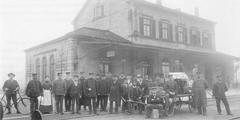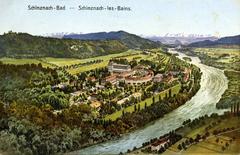Storchenturm Brugg: Visiting Hours, Tickets, and Historical Significance
Date: 14/06/2025
Introduction
On the western edge of Brugg’s historic old town stands the Storchenturm—translated as “Stork Tower”—a captivating medieval landmark that embodies the region’s rich history and enduring cultural heritage. Dating back to the 13th century, this fortified tower was originally a crucial defensive structure and city gate, protecting Brugg’s strategic position at the confluence of the Aare, Reuss, and Limmat rivers. Today, the tower invites visitors to explore both Brugg’s medieval origins and its vibrant contemporary community life.
This comprehensive guide provides detailed information on Storchenturm’s visiting hours, ticketing, accessibility, and travel tips. It also delves into the tower’s historical context, architectural features, and its role as a living center for cultural events, urban development, and tourism. Whether you are a history enthusiast, a family traveler, or a cultural explorer, this article equips you with everything you need for a rewarding visit to one of Switzerland’s most iconic medieval landmarks (Brugg Tourism, myswitzerland.com, Aargauer Zeitung).
Medieval Origins and Historical Context
Storchenturm is among the last surviving towers from Brugg’s original 13th and 14th-century fortifications. The town’s name, derived from the Swiss German word for “bridge,” reflects its foundational role as a strategic crossing point. Under the Habsburgs, Brugg became an important hub for trade and defense, and Storchenturm, along with towers such as the Archivturm and Eckturm, formed a protective ring leveraging the town’s natural topography.
The Storchenturm served as both lookout and deterrent, integrating seamlessly into a sophisticated defensive network. Its enduring presence tells the story of Brugg’s evolution from Roman times through the Middle Ages and into the present.
Architectural Features and Construction
Constructed with robust shell limestone walls characteristic of Swiss medieval military architecture, the Storchenturm emphasizes defense over ornamentation. The surviving lower half of the tower still impresses with its imposing structure. Narrow slit windows provided archers with vantage points, and the original entrance was probably accessible only via removable stairs—an effective security measure.
Role in Brugg’s Urban Development
As Brugg expanded, many medieval defenses were incorporated into new buildings or dismantled, but Storchenturm remains a tangible link to the town’s fortified past. Today, visitors can observe how historic stonework interacts with modern interventions, illustrating Brugg’s layered history and ongoing urban development.
Cultural and Symbolic Significance
The “Stork Tower” name likely originates from the storks that once nested on its roof—a symbol of good fortune in Swiss culture. Beyond its architectural value, Storchenturm stands as a symbol of resilience and continuity, anchoring local identity and hosting traditions that bridge past and present.
Preservation and Heritage Status
Storchenturm is officially recognized as a Swiss site of national significance. Ongoing restoration efforts honor its historical integrity, employing traditional materials and methods to ensure the tower remains accessible and meaningful for future generations.
Practical Visitor Information
Visiting Hours
- Exterior: Accessible year-round.
- Interior: Open for special events, guided tours, and during the renowned Advent candle-making event (“Kerzenziehen”). For up-to-date hours, consult the official tourism website or contact the Brugg Tourism Office.
Tickets
- Exterior viewing: Free of charge.
- Interior access & events: CHF 5 for adults; discounts available for children, students, and seniors. Children under 6 often enter free. Tickets can be purchased online, at the Vindonissa Museum ticket desk, or at the local information center. Advance booking is recommended during peak times and special events.
Accessibility
- The exterior is wheelchair accessible via paved paths.
- Due to medieval architecture, interior access is limited for wheelchair users; inquire in advance about specific accommodations.
- The old town and event areas are pedestrian-friendly.
Travel Tips
- For photography, visit during golden hour for the best light.
- Spring and autumn offer mild weather and fewer crowds.
- Layer clothing for Switzerland’s variable climate (Happy to Wander).
- Shops and attractions typically close by 6:30–7:00 PM; tipping is optional but rounding up is customary.
Storchenturm as a Community Hub
Kerzenziehen: A Living Tradition
Every Advent, Storchenturm hosts “Kerzenziehen,” a beloved candle-making event. Begun in 1975 and relocated to the tower in 2001, it draws hundreds of families and school groups who craft beeswax candles in a meditative, intergenerational setting. About 25 groups participate, using 300–400 kg of wax annually. Proceeds support local youth work, reinforcing Storchenturm’s community role (p-i-c.ch, Aargauer Zeitung).
Civic Participation and Urban Development
Situated near the Effingerhof complex, Storchenturm anchors Brugg’s participatory urban development. The “Runder Tisch Altstadt” initiative unites residents, businesses, and officials to revitalize the city center (Aargauer Zeitung). Recent enhancements include public seating and greenery, balancing resident and visitor needs.
Exploring Storchenturm and Surroundings
Location
Storchenturm sits at Brugg’s old town edge, adjacent to the Effingerhof and near the Vindonissa Museum (Mapcarta). Storchengasse, the tower’s street, is lined with historic architecture and green spaces.
Getting There
- By Train: Ten-minute walk from Brugg AG station. The station offers modern amenities and connections from Zurich and Basel (sbb.ch).
- By Car: Parking at Storchenplatz car park; spaces fill up during peak times.
Accessibility
Recent landscaping around Storchenturm and the Effingerhof features gentle gradients and smooth walkways for wheelchair users.
Facilities
- Public restrooms: Vindonissa Museum and Effingerhof
- Café: Soon to open in the Effingerhof
- Lockers: Available at Brugg train station
Guided Tours and Special Events
- Guided Tours: Offered weekly on Saturdays (11:00 AM & 2:00 PM). Include in-depth historical context and access to restricted areas.
- Special Events: Medieval fairs, heritage days, art exhibitions, and reenactments occur throughout the year; see the city events calendar.
Thematic Walking Routes
Medieval and Roman Heritage Trail
Begin at Storchenturm and follow a marked path through the old town, including:
- Vindonissa Museum: Roman camp artifacts and exhibits
- Stadtmuseum Brugg: Local medieval and modern history
- Promenade Lift and Limmat Footbridge: Panoramic river and town views
River and Nature Circuit
Start at Storchenturm and loop along the Aare, crossing the Limmat Footbridge and returning via the Reuss river, highlighting Brugg’s natural beauty (swissactivities.com).
Pairing with Local Attractions
- Vindonissa Museum: Roman history, across from the tower (myswitzerland.com)
- Stadtbibliothek Brugg: Library and cultural events in Effingerhof
- Restaurants: Sample Aargau specialties at nearby eateries like essen’z or La Dolce Vita
Family-Friendly and Educational Experiences
- Educational Tours: Engage children with interactive exhibits and guided walks.
- Brugg Railway Park: Learn about Swiss railway history.
- Nature Walks: Explore riverside ecology and local geography.
Sustainability and Preservation
All renovations respect Brugg’s historic character, maintaining authenticity and balancing modern sustainability. Modern installations are discreet to preserve the cityscape (Aargauer Zeitung).
Frequently Asked Questions (FAQ)
What are the Storchenturm visiting hours?
Exterior is accessible year-round. Interior is open during special events and tours, typically 10:00 AM–5:00 PM, Tuesday–Sunday (closed Mondays).
How much are tickets?
CHF 5 for adults; discounts for children, students, and seniors. Children under 6 free.
Are guided tours available?
Yes, offered on Saturdays and during special events. Book via the tourism website.
Is Storchenturm wheelchair accessible?
The exterior and surrounding areas are accessible; interior access is limited.
Where can I park?
Parking at Storchenplatz car park near the tower; arrive early for best availability.
What else can I see nearby?
Vindonissa Museum, Stadtmuseum Brugg, Brugg Railway Park, and riverside parks.
Visuals, Media, and Further Planning
- High-quality images and virtual tours are available on the Brugg tourism website.
- Optimized alt tags such as “Storchenturm Brugg historical site” and “Kerzenziehen candle-making event” enhance accessibility and SEO.
Conclusion
The Storchenturm is not only a monument to medieval architecture but a living hub for Brugg’s cultural, civic, and community life. With well-maintained facilities, accessible surroundings, and a calendar filled with tradition and innovation, the tower offers a rewarding destination for all travelers. Plan your visit to explore the tower’s history, participate in local events, and discover the vibrant tapestry of Brugg’s heritage.
Stay updated by visiting the Brugg tourism website, downloading the Audiala app, and following local channels for the latest tips and events.
Sources and Further Reading
- Storchenturm Visiting Hours, Tickets & History: Exploring Brugg’s Medieval Landmark (Brugg Tourism)
- Storchenturm Brugg: Visiting Hours, Tickets, and Community Events (Tourismus Brugg)
- Storchenturm Visiting Hours, Tickets, and Tips: Exploring Brugg’s Historic Sites (Mapcarta)
- Visiting Storchenturm in Brugg: Hours, Tickets, and Top Historical Sites to Explore (myswitzerland.com)
- Kerzenziehen im Advent (p-i-c.ch)
- Beim Kerzenziehen hat’s selbst der Zappelige plötzlich Geduld, Aargauer Zeitung (2023) (Aargauer Zeitung)
- Brugg Effingerhof: Private Eigentümerin und Stadt teilen sich die Kosten für die Außengestaltung, Aargauer Zeitung (2023) (Aargauer Zeitung)
- Brugg Altstadt Entwicklung: Runder Tisch Altstadt, Aargauer Zeitung (2024) (Aargauer Zeitung)
- Brugg AG railway station information, SBB Swiss Federal Railways (sbb.ch)
- Switzerland Travel Tips, Happy to Wander (Happy to Wander)
- Swiss Activities Brugg (swissactivities.com)

